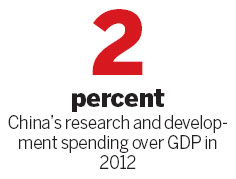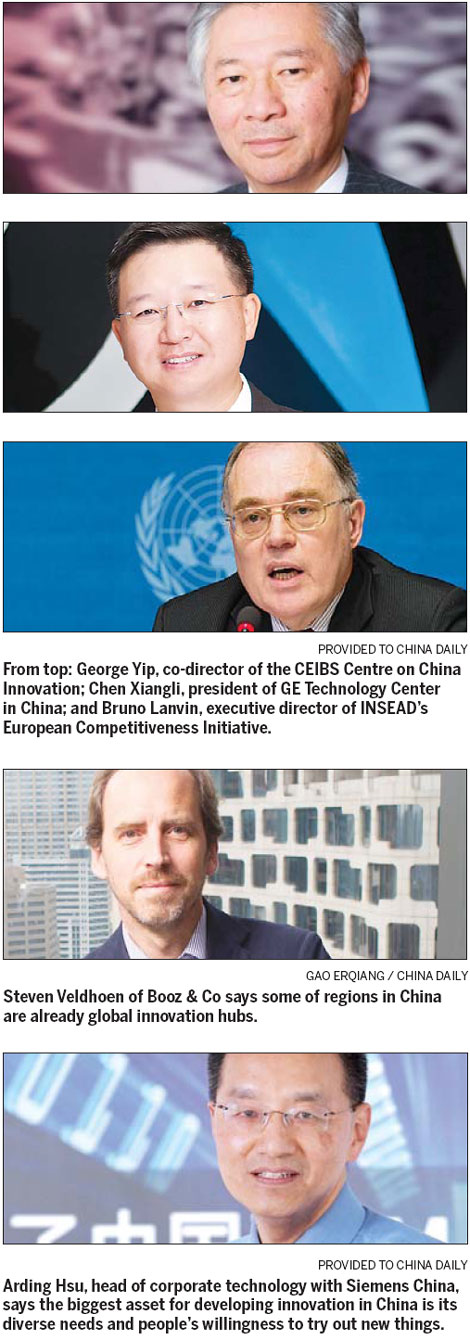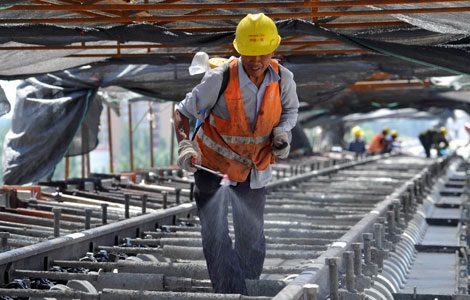Playing a trump card in global business
Updated: 2013-07-15 07:24
By Meng Jing (China Daily)
|
||||||||
Knowledge factor
The Ministry of Commerce says there are about 1,200 foreign multinational R&D centers in China, representing a total investment of about $12.8 billion in 2010.
Though cost was the key-driving factor a decade ago, foreign companies' interests in coming to China for R&D are now largely driven by market conditions and knowledge factors.
Yuan Qingbin, head of Hershey's Asia innovation center, admits the main reason that prompted the US company to set up an R&D facility in Shanghai was the robust sales performance and growing middle-class in China, particular considering the sales performance in developed markets.
"China is currently Hershey's fastest growth market, moving from No 7 to No 3 in chocolate share in just five years with overall chocolate share more than quadrupling by 2012. So we are betting big on China," he says.
The cost of Chinese talent is no longer an advantage for the company, according to Yuan. Some of the top Chinese R&D expertise can sometimes cost more than the equivalent in the US because of scarcity.
Paul Ebertz, vice-president and global HTS-aerospace leader at Honeywell Aerospace, says his company has identified China as a key growth market and intends to double the current Chinese R&D workforce of 350 over the next few years.

"Commercial aviation growth in Asia-Pacific is still on the upswing and our decision to house the APAC headquarters in Shanghai clearly underlines the importance of China in Honeywell's overall technical innovation and growth strategy," Ebertz says.
Despite the big market, Arding Hsu, the head of corporate technology with Siemens China, says the biggest asset for developing innovation in China and the main driving force for China's future role as a global innovation hub is the country's diverse needs and its people's willingness to try out new things.
"There is no country in the world that has as many diversified demands as China," he says. "As long as we can understand the needs of Chinese customers, there are better chances for us to become game changers."
Hsu cites his company's WLAN-based moving block technology as an example. The technology, which was developed in China based on the needs of transferring huge numbers of passengers through the subway network in China's megacities, has successfully reduced train interval times from 3 minutes to as short as 80 seconds in real-time operations.
Siemens is not the only company to have discovered that made-for-China products can be sold in other countries as well. According to Booz & Co's report in 2012, which surveyed 100 Chinese and multinational companies in China, the importance of China for companies as a regional and even global hub for innovation is clear.
Nearly 40 percent of the multinational companies and 50 percent of Chinese companies surveyed already develop products in China for markets outside the country. This trend is set to intensify, with the survey finding that, by 2022, more than 60 percent of all multinational companies and local companies expect to conduct R&D in China for global markets.
Future perfect
All the experts agree that China will be a major global innovation hub in the future. Many feel the country's ability to spur creativity and attract talent will be the core issue that it will need to tackle if it wants to be the global innovation hub.
George Yip, co-director of the Shanghai-based CEIBS Centre on China Innovation, says that in the next couple of years, China can indeed become a global innovation hub. "But, in China, people always talk about being the No 1, so it is still a long way off," Yip says, adding that it depends on individual industries.
"In the next decade, China will be one of the top innovation hubs for labor and engineering intensive sectors, such as telephones, in which China has already done a lot of work."
In the automobile industry, China is still far behind. It will be 20 years before it can reach the peak. For aerospace, it could take as long as 30 years, Yip says. China has lower per capita income than the US and Japan, but even countries such as Japan have become global innovation leaders only in certain categories.
Chen Xiangli, president of GE Technology Center in China, agrees, saying it will be difficult for China to overtake the US in innovation in the foreseeable future, as the latter is still an attractive destination for most top-quality talent. His R&D team in China has made significant progress since the center was set up in Shanghai in 2000, he says.
"For the first five years, our focus was to learn how to localize the products developed by GE's R&D labs in other parts of the world. Then over the next five years, we started to develop products for Chinese customers. Over the past two to three years we've been developing products for China as well as the rest of the world.
"For some products, more than 80 percent of our research outcome is now sold to countries outside China," Chen says, adding that the trend signifies the growing capability of Chinese innovators.
But he still believes talent is the key challenge for China because R&D has a long history in the US, thereby creating a huge pool of experienced professionals. "The majority of our R&D team in China has work experience of less than five years, but in the US you can find a lot of people with 20 to 30 years of experience."
But that is not the end of the story for China, Chen says. China's real opportunity in innovation lies in the middle-end products, which do not require the most complicated science skills but are still in high demand not only in China but also in other emerging as well as developed economies, he says.
Shen Jingting and Wang Wen contributed to this story.
mengjing@chinadaily.com.cn


 US star sprinter fails drug test
US star sprinter fails drug test
 Protests erupt after verdict
Protests erupt after verdict
 Color Run in London promotes healthy living
Color Run in London promotes healthy living
 Urumqi residents hand in weapons
Urumqi residents hand in weapons
 Pool jammed in summer heat
Pool jammed in summer heat
 Last stop for the telegrams of India
Last stop for the telegrams of India
 Heavy rain, strong winds as Soulik heads inland
Heavy rain, strong winds as Soulik heads inland
 8 dead, 19 injured after bus leaves road in Jinghong
8 dead, 19 injured after bus leaves road in Jinghong
Most Viewed
Editor's Picks

|

|

|

|

|

|
Today's Top News
Four GSK China execs held for investigation
Asiana survivors coping with post traumatic stress
China's Q2 GDP growth slows to 7.5%
Canada mourns victims of train accident
Air crash students return to families
Snowden says he won't release harmful US data
Local governments face financing woes
Zimmerman not guilty
US Weekly

|

|






